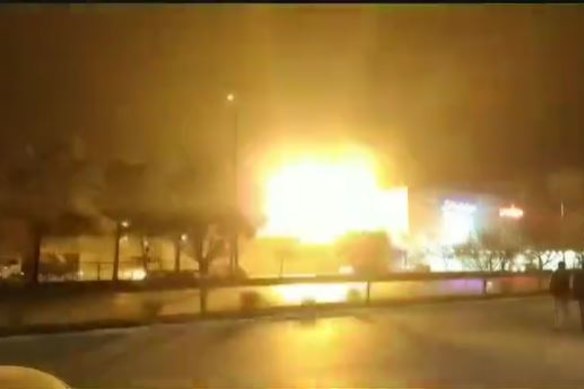Shadow war: How Israel and Iran attack each other

New York: Of the many conflicts in the Middle East, the one between Iran and Israel is the most potentially explosive.
Iranian leaders periodically vow to annihilate Israel and are suspected of pursuing nuclear weapons that would back the threat.
A screenshot of video of the drone attack on a military industry factory in the central Iranian city of Isfahan.Credit:Twitter
Israel, which is thought to have such arms, has committed to doing whatever it takes to prevent Iran from acquiring them.
For years, the two have engaged in a shadow war, quietly attacking each other on land, by air and at sea, in some cases by proxy. They have mostly sought to avoid open clashes that would risk escalation to all-out war, preferring instead to act with plausible deniability.
But lately, the clashes have become more conspicuous. After an Iranian ammunition depot was attacked in a drone strike January 28, two US outlets reported that Israel was responsible.
1. Why are Iran and Israel enemies?
They were allies starting in the 1950s during the reign of Iran’s last monarch, Shah Mohammad Reza Pahlavi, but the friendship abruptly ended with the Islamic revolution in Iran 1979. The country’s new leaders adopted a strong anti-Israel stance, decrying the Jewish state as an imperialist power in the Middle East.
Iran has supported groups that regularly fight Israel, notably Hezbollah in Lebanon and the Palestinian group Hamas.
Israel regards Iran’s potential to build nuclear weapons as a threat to its existence and is thought to be behind a campaign of sabotage against the country’s atomic program.
2. What happened with the Iranian ammunition depot?
Iranian officials said a defence ministry complex near the central city of Isfahan was targeted by three unmanned drones.
One of them hit a building causing minor damage, they said.
The Wall Street Journal and New York Times reported that Israel was responsible. The attack came amid Western condemnation of Iran for supplying military drones to Russia for use in its war on Ukraine.
3. Where did the shadow war begin?
Lebanon is the oldest front in the battle and is fought indirectly. In reaction to Israel’s invasion of the country’s south in 1982, a militia that would become Hezbollah was formed by Lebanese Muslims belonging to the Shiite branch of Islam dominant in Iran.
Their group to some extent became a proxy for Iran’s premier security force, the Islamic Revolutionary Guard Corps.
Since the last war between Israel and Lebanon in 2006, Hezbollah’s military wing has built what Israel says is a vast arsenal of rockets and missiles along the border.
Israeli forces have repeatedly struck at Hezbollah’s rocket pipeline within Lebanon, according to media reports; the militia has on occasion retaliated by firing rockets into Israel and attacking Israeli troops along the border.
A neighbouring battleground for Israel and Iran opened up in 2011, when Syria erupted in civil war.
4. What’s happened in Syria?
Through the course of Syria’s war, Iran has built up a military presence in the country to support its ally, President Bashar al-Assad, and to facilitate the transfer by land of weaponry meant for Hezbollah from Iran to Lebanon via Iraq and Syria.
In an effort to stop the arms flow and counter this second hostile presence on its northern border, Israel has conducted air strikes in Syria against targets linked to Iran.
Some Iranians have died, according to media accounts.
5. What’s happened at sea?
Tit-for-tat attacks on commercial vessels began in 2019. Although neither Israel nor Iran has accepted responsibility for the hits on ships connected to the other, they are widely thought to be to behind them.
Loss of life has been rare, but in July 2021, a British and a Romanian crew member were killed when an Israeli-operated ship was struck in the Gulf of Oman by a drone that US officials linked to Iran.
Previous targets have included Iranian tankers carrying oil destined for Syria; an Iranian ship off the coast of Yemen that served as a floating base for the Revolutionary Guards; and cargo ships belonging to or linked to Israelis.
6. What about prior attacks inside the two countries?
Though Iran has mostly absorbed Israeli strikes on its interests in Syria, in 2018 its forces there fired a barrage of missiles toward Israeli positions in the Golan Heights, a plateau Israel captured from Syria in the 1967 war and later annexed.
Israel replied with a much greater show of force. For its part, Israel is widely thought to be behind the assassination in Tehran of five Iranian nuclear scientists since 2010 and several attacks on nuclear sites inside Iran.
In April 2021, Iran blamed Israel and vowed revenge for an explosion at its largest uranium enrichment facility in Natanz, which it said caused significant damage to its centrifuges. It was the second time in less than a year that the site had been hit by a suspicious blast.
Israel neither confirmed nor denied it was responsible for either attack. In October 2021, an Iranian general said Israel was likely behind a cyberattack that paralysed gas stations across Iran.
7. Is all-out war a possibility?
The biggest risk of that is connected to Iran’s nuclear program. The country’s leaders say they have no ambition to build nuclear weapons. The Israelis point to a cache of documents their intelligence spirited out of Iran in 2018 that suggests otherwise. Israeli officials have repeatedly implied that if Iran were to reach the brink of weapons capability, they would attack its nuclear program using air power, as they did Iraq’s in 1981 and Syria’s in 2007.
Bloomberg
Get a note directly from our foreign correspondents on what’s making headlines around the world. Sign up for the weekly What in the World newsletter here.
Most Viewed in World
From our partners
Source: Read Full Article
